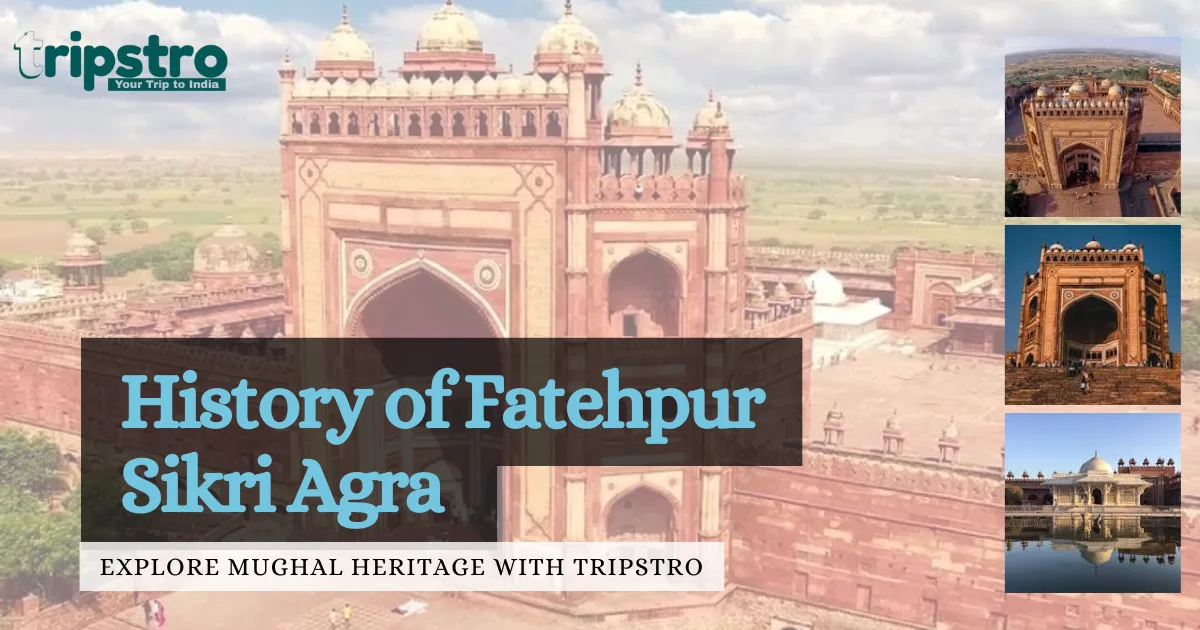Fatehpur Sikri is one of the most magnificent and historically rich cities in India. Located near Agra in Uttar Pradesh, this UNESCO World Heritage Site showcases the grandeur of Mughal architecture and the vision of Emperor Akbar. At Tripstro – Your Trip To India, we aim to take you beyond just sightseeing we help you experience the soul of Mughal India. Whether you’re booking an Agra Fatehpur Sikri Tour Package or exploring on your own, understanding the History of Fatehpur Sikri Agra adds immense depth to your journey.
The Glorious History of Fatehpur Sikri
The History of Fatehpur Sikri Agra begins in the 16th century when Mughal Emperor Akbar decided to establish a new capital. In 1569, Akbar visited the Sufi saint Sheikh Salim Chishti, who lived in the small village of Sikri. The saint predicted that Akbar would soon have a son, and the prophecy came true with the birth of Prince Salim (later Emperor Jahangir). To honor the saint, Akbar built a magnificent city and named it Fatehpur Sikri, meaning “City of Victory.” The construction began around 1571 and was completed in 1573. For nearly 14 years, Fatehpur Sikri remained the Mughal Empire’s capital before it was mysteriously abandoned. The city represents a perfect blend of Persian, Islamic, and Indian architectural styles, making it one of the most well-planned urban centers of medieval India.
Architectural Marvels of Fatehpur Sikri
Fatehpur Sikri isn’t just a historical city — it’s an open-air museum of Mughal design brilliance. Built entirely from red sandstone, it’s a testament to Akbar’s artistic and architectural vision.
Key Architectural Highlights:
- Buland Darwaza: The “Gate of Magnificence,” built in 1601 to commemorate Akbar’s victory in Gujarat. At 54 meters high, it’s one of the largest gateways in the world.
- Jama Masjid: One of the earliest and most beautiful mosques built by the Mughals, combining Persian and Indian design elements.
- Tomb of Salim Chishti: The white marble tomb of the Sufi saint who blessed Akbar, symbolizing faith and devotion.
- Panch Mahal: A five-story palace used by royal ladies for leisure, offering panoramic views of the city.
- Diwan-i-Khas (Hall of Private Audience): Known for its unique central pillar with a beautifully carved capital.
- Diwan-i-Aam (Hall of Public Audience): Where Akbar addressed the general public and heard petitions.
These architectural wonders form the core of the Agra Fatehpur Sikri Tour Package, drawing visitors from all over the world.
Why Fatehpur Sikri Was Abandoned
One of the most intriguing mysteries in Indian history is why Fatehpur Sikri was abandoned so soon after its completion. Historians suggest several reasons:
- Water Scarcity: The region faced a lack of sufficient water supply to sustain the population.
- Proximity to Rajasthan: The semi-arid climate made agriculture difficult.
- Strategic Concerns: The Mughal empire’s expanding borders required Akbar to move closer to Lahore for better control.
Despite its short-lived reign as a capital, Fatehpur Sikri remains a symbol of Mughal grandeur and architectural genius.
Exploring Fatehpur Sikri: Key Monuments & Attractions
If you’re planning a trip through Tripstro – Your Trip To India, here’s what your Agra Fatehpur Sikri Tour Package should include:
| Monument/Attraction | Highlights |
| Buland Darwaza | Tallest gateway in the world, inscription from the Quran. |
| Jama Masjid | Massive courtyard, blend of Persian and Indian style. |
| Salim Chishti’s Tomb | Beautiful white marble, intricate latticework. |
| Panch Mahal | Five-tiered pavilion, open architecture. |
| Birbal’s House | Residence of Akbar’s witty advisor, Hindu-style carvings. |
| Jodha Bai’s Palace | Akbar’s Rajput queen’s palace, elegant fusion of styles. |
Each of these spots contributes to the unique historical and cultural value of Fatehpur Sikri Agra.
How to Reach Fatehpur Sikri
Planning how to reach Fatehpur Sikri is essential for a smooth trip. The city is well-connected by road, rail, and air.
By Air: The nearest airport is Agra Airport (Kheria Airport), approximately 40 km away. You can book flights from major Indian cities like Delhi, Mumbai, and Jaipur.
By Train: The Fatehpur Sikri Railway Station connects to Agra, Jaipur, and Delhi. Trains are frequent and affordable.
By Road: From Agra, Fatehpur Sikri is just 37 km (approx. 1-hour drive) via NH21. Regular buses, taxis, and private cabs are available.
Tripstro – Your Trip To India also offers customized transfers in their Agra Fatehpur Sikri Tour Package for your convenience.
Best Time to Visit Fatehpur Sikri
If you’re wondering about the best time to visit Fatehpur Sikri, plan your trip between October and March. During these months, the weather is pleasant for sightseeing.
- Summer (April–June): Hot and dry; sightseeing is best done early morning.
- Monsoon (July–September): Occasional rain enhances the red sandstone beauty.
- Winter (October–March): Ideal season for exploring comfortably.
This makes winter the top pick for travelers booking an Agra Fatehpur Sikri Tour Package.
Fatehpur Sikri Tickets & Timings
Planning your visit is easier when you know the Fatehpur Sikri Tickets and Timings.
- Opening Hours: 6:00 AM to 6:00 PM (Every day)
- Entry Fee:
- ₹50 for Indian citizens
- ₹610 for foreign tourists
- Free entry for children under 15 years
- ₹50 for Indian citizens
Tickets are available both online and at the counter. Tripstro – Your Trip To India can include these in your Agra Fatehpur Sikri Tour Package, saving you time and effort.
Taj Mahal and Fatehpur Sikri in One Day – Is It Possible?
Absolutely! Many tourists plan to see both the Taj Mahal and Fatehpur Sikri in one day.
Here’s a quick guide:
- Morning: Visit the Taj Mahal at sunrise (best lighting).
- Afternoon: Depart for Fatehpur Sikri (approx. 1-hour drive).
- Evening: Explore major monuments and return to Agra by nightfall.
If you book through Tripstro – Your Trip To India, their guides will ensure you don’t miss the key experiences of either site.
Conclusion
The History of Fatehpur Sikri Agra tells a story of ambition, spirituality, and architectural mastery. From Akbar’s dream city to its mysterious abandonment, every stone echoes the Mughal Empire’s glory. Whether you’re a history lover, architecture enthusiast, or traveler seeking authentic experiences, Fatehpur Sikri is a must-visit destination. At Tripstro – Your Trip To India, we offer customized Agra Fatehpur Sikri Tour Packages that let you explore this UNESCO World Heritage Site with expert guides, comfortable travel, and local experiences. Book your journey today and walk through the echoes of Mughal grandeur!
FAQs
Q1. Who built Fatehpur Sikri and when?
Fatehpur Sikri was built by Emperor Akbar between 1571 and 1573 to commemorate the prophecy of Sufi saint Sheikh Salim Chishti.
Q2. Why was Fatehpur Sikri abandoned?
The main reasons were water scarcity and strategic relocation closer to the empire’s northern borders.
Q3. What are the major attractions in Fatehpur Sikri?
The major attractions include Buland Darwaza, Salim Chishti’s Tomb, Panch Mahal, and Jodha Bai’s Palace.
Q4. Can I visit the Taj Mahal and Fatehpur Sikri in one day?
Yes, both sites can be comfortably explored in one day if you start early.
Q5. Is Fatehpur Sikri included in most Agra tour packages?
Yes, it’s a major inclusion in most Agra Fatehpur Sikri Tour Packages offered by travel agencies like Tripstro – Your Trip To India.





 //
//
